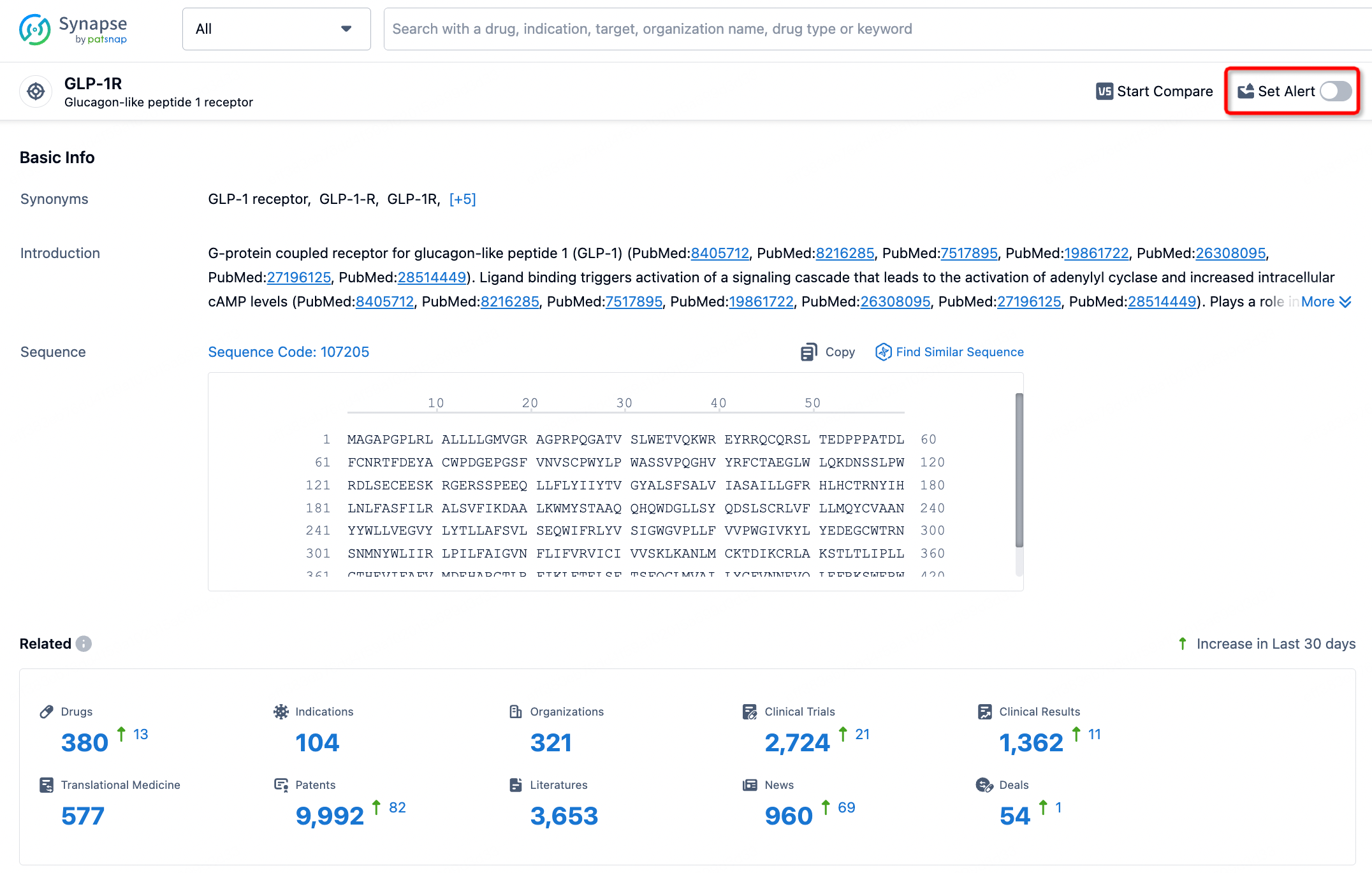Request Demo
What are SSTR agonists and how do they work?
21 June 2024
In the realm of medical science, SSTR agonists are emerging as powerful tools with significant therapeutic potential. But what exactly are SSTR agonists, and how do they operate within the human body? This blog delves into the intricacies of these compounds, their mechanisms of action, and their diverse applications in medicine.
SSTR, or somatostatin receptors, are proteins found on the surface of certain cells in the body. They are named after somatostatin, a hormone that inhibits the release of several other hormones and plays a role in regulating the endocrine system, neurotransmission, and cell proliferation. SSTRs are involved in numerous physiological processes, making them intriguing targets for therapeutic intervention. SSTR agonists are compounds that bind to and activate these receptors, mimicking the action of natural somatostatin.
SSTR agonists work by binding to somatostatin receptors, which are G-protein-coupled receptors (GPCRs). This binding initiates a cascade of intracellular events that result in the modulation of various cellular functions. The human body has five known subtypes of SSTRs, named SSTR1 through SSTR5, each with distinct tissue distributions and functional roles. When an SSTR agonist binds to its corresponding receptor, it can inhibit the release of substances such as growth hormone, insulin, glucagon, and other gut hormones by acting directly on the cells that produce these hormones.
The mechanism of action of SSTR agonists primarily involves the inhibition of adenylyl cyclase, leading to a decrease in the levels of cyclic AMP (cAMP) within the cell. This decrease in cAMP levels subsequently inhibits the release of hormones. Additionally, SSTR agonists can activate phosphotyrosine phosphatases, which lead to the dephosphorylation of various proteins, further influencing cellular activities. By modulating these pathways, SSTR agonists exert their inhibitory effects on hormone secretion and cell proliferation, making them valuable in treating conditions characterized by excessive hormone production and abnormal cell growth.
One of the most well-known uses of SSTR agonists is in the treatment of acromegaly, a condition caused by an excess of growth hormone. In patients with acromegaly, SSTR agonists such as octreotide and lanreotide can effectively reduce growth hormone levels, alleviating symptoms and preventing complications associated with the disease. These drugs work by binding to SSTRs on pituitary adenomas (tumors) that produce growth hormone, inhibiting the secretion and thereby controlling the disease.
SSTR agonists are also employed in managing neuroendocrine tumors (NETs), a diverse group of malignancies that arise from cells of the neuroendocrine system. NETs often express high levels of SSTRs, making them ideal targets for SSTR agonist therapy. By binding to these receptors, the agonists can inhibit tumor growth and hormone secretion, improving patients' quality of life and overall prognosis. In addition, SSTR agonists can be conjugated with radioactive isotopes to create radiolabeled analogs, which are used in peptide receptor radionuclide therapy (PRRT). PRRT delivers targeted radiation to tumor cells expressing SSTRs, offering a powerful therapeutic option for patients with advanced NETs.
Beyond their use in acromegaly and NETs, SSTR agonists are being investigated for their potential in treating other conditions. For example, researchers are exploring their utility in managing hyperinsulinism, a condition characterized by excessive insulin production, and in treating certain gastrointestinal disorders where hormone regulation is disrupted. Moreover, the anti-proliferative properties of SSTR agonists have sparked interest in their potential applications in oncology, as they may help inhibit the growth of various types of cancer cells.
In conclusion, SSTR agonists represent a promising class of therapeutic agents with a broad range of applications. By activating somatostatin receptors, these compounds can regulate hormone secretion and inhibit abnormal cell growth, offering effective treatments for conditions like acromegaly and neuroendocrine tumors. As research continues to uncover new potential uses for SSTR agonists, their role in medicine is likely to expand, providing new hope for patients with a variety of challenging conditions.
SSTR, or somatostatin receptors, are proteins found on the surface of certain cells in the body. They are named after somatostatin, a hormone that inhibits the release of several other hormones and plays a role in regulating the endocrine system, neurotransmission, and cell proliferation. SSTRs are involved in numerous physiological processes, making them intriguing targets for therapeutic intervention. SSTR agonists are compounds that bind to and activate these receptors, mimicking the action of natural somatostatin.
SSTR agonists work by binding to somatostatin receptors, which are G-protein-coupled receptors (GPCRs). This binding initiates a cascade of intracellular events that result in the modulation of various cellular functions. The human body has five known subtypes of SSTRs, named SSTR1 through SSTR5, each with distinct tissue distributions and functional roles. When an SSTR agonist binds to its corresponding receptor, it can inhibit the release of substances such as growth hormone, insulin, glucagon, and other gut hormones by acting directly on the cells that produce these hormones.
The mechanism of action of SSTR agonists primarily involves the inhibition of adenylyl cyclase, leading to a decrease in the levels of cyclic AMP (cAMP) within the cell. This decrease in cAMP levels subsequently inhibits the release of hormones. Additionally, SSTR agonists can activate phosphotyrosine phosphatases, which lead to the dephosphorylation of various proteins, further influencing cellular activities. By modulating these pathways, SSTR agonists exert their inhibitory effects on hormone secretion and cell proliferation, making them valuable in treating conditions characterized by excessive hormone production and abnormal cell growth.
One of the most well-known uses of SSTR agonists is in the treatment of acromegaly, a condition caused by an excess of growth hormone. In patients with acromegaly, SSTR agonists such as octreotide and lanreotide can effectively reduce growth hormone levels, alleviating symptoms and preventing complications associated with the disease. These drugs work by binding to SSTRs on pituitary adenomas (tumors) that produce growth hormone, inhibiting the secretion and thereby controlling the disease.
SSTR agonists are also employed in managing neuroendocrine tumors (NETs), a diverse group of malignancies that arise from cells of the neuroendocrine system. NETs often express high levels of SSTRs, making them ideal targets for SSTR agonist therapy. By binding to these receptors, the agonists can inhibit tumor growth and hormone secretion, improving patients' quality of life and overall prognosis. In addition, SSTR agonists can be conjugated with radioactive isotopes to create radiolabeled analogs, which are used in peptide receptor radionuclide therapy (PRRT). PRRT delivers targeted radiation to tumor cells expressing SSTRs, offering a powerful therapeutic option for patients with advanced NETs.
Beyond their use in acromegaly and NETs, SSTR agonists are being investigated for their potential in treating other conditions. For example, researchers are exploring their utility in managing hyperinsulinism, a condition characterized by excessive insulin production, and in treating certain gastrointestinal disorders where hormone regulation is disrupted. Moreover, the anti-proliferative properties of SSTR agonists have sparked interest in their potential applications in oncology, as they may help inhibit the growth of various types of cancer cells.
In conclusion, SSTR agonists represent a promising class of therapeutic agents with a broad range of applications. By activating somatostatin receptors, these compounds can regulate hormone secretion and inhibit abnormal cell growth, offering effective treatments for conditions like acromegaly and neuroendocrine tumors. As research continues to uncover new potential uses for SSTR agonists, their role in medicine is likely to expand, providing new hope for patients with a variety of challenging conditions.
How to obtain the latest development progress of all targets?
In the Synapse database, you can stay updated on the latest research and development advances of all targets. This service is accessible anytime and anywhere, with updates available daily or weekly. Use the "Set Alert" function to stay informed. Click on the image below to embark on a brand new journey of drug discovery!
AI Agents Built for Biopharma Breakthroughs
Accelerate discovery. Empower decisions. Transform outcomes.
Get started for free today!
Accelerate Strategic R&D decision making with Synapse, PatSnap’s AI-powered Connected Innovation Intelligence Platform Built for Life Sciences Professionals.
Start your data trial now!
Synapse data is also accessible to external entities via APIs or data packages. Empower better decisions with the latest in pharmaceutical intelligence.


